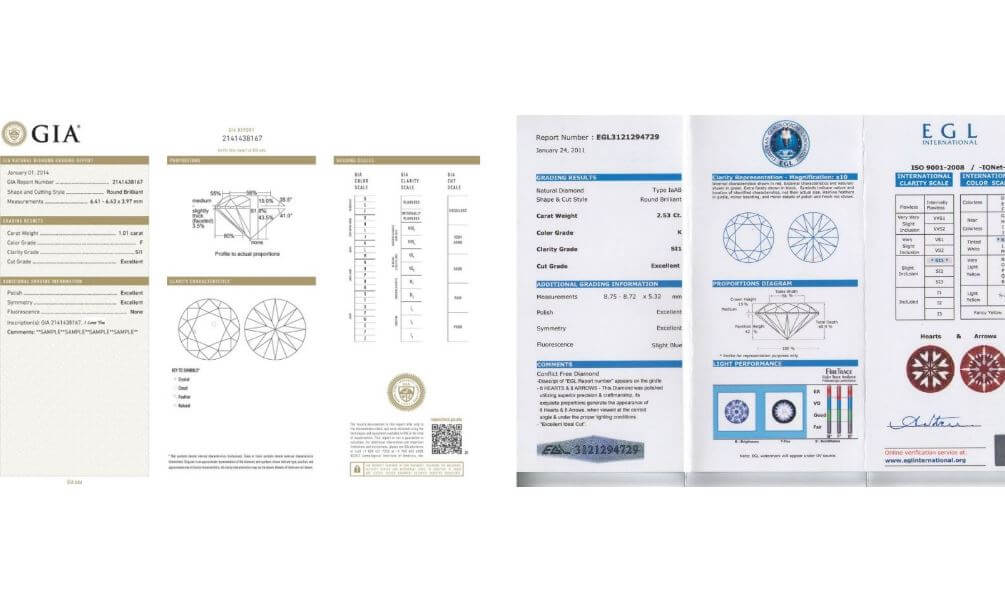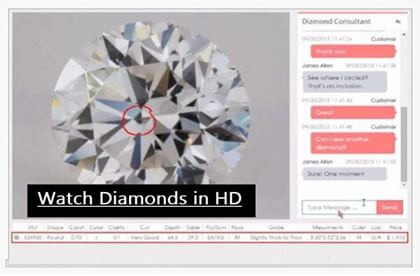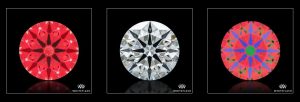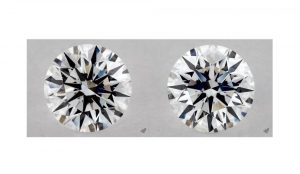Buying a certified diamond is very important for the buyer who wants to get the best diamonds in the market. Diamond certification ensures that all the different parts of a diamond are graded and they are up to an expected standard that the consumers expect. In the absence of certification, it becomes very easy to buy a substandard diamond at a very expensive price. Buying a certified diamond ensures that you buy the best diamonds at the best price. You get the value for your money with certified diamonds.
There are however different diamond grading laboratories that make use of different standards to evaluate the quality of a diamond. These differing standards lead to discrepancies in their grading reports for identical diamond, even the same diamonds. These discrepancies have led to comparisons of the different grading laboratories and consequently some laboratories gaining more trust while others lose their trustworthiness. The GIA and EGL are two of such grading laboratories with differing views in the diamond world.
GIA – Gemological Institute Of America
The GIA was established in the year 1931 and till date is one of the most reliable and trustworthy diamond grading laboratories. As a matter of fact, most of the standards for measuring the quality of the 4Cs of a diamond and their respective components being used in the market today was invented by the GIA and is the popularly accepted standard.
The GIA is reputed as a worldwide body that have earned their trust by showing consistency over the years in adhering to strict standards to determine the quality of a diamond. The GIA makes use of all diamond parameters alongside other criteria like the cut and shape of the diamond, the diamond table, depth, culet size, symmetry, diamond’s evaluation date, the thickness of the diamond’s girdle, polish grade, diamond cut grade, proportion diagram, diamond color grade, diamond clarity grade, diamond plot showing all the inclusions and blemishes in the diamond, fluorescence grade, measurements (mm), carat weight, laser inscription and security features. All of these criteria carefully determined by the GIA determines how the quality and the value of the diamond in the market.
The most subjective of the criteria used to evaluate a diamond are the color and clarity grade scales. This is where many other grading laboratories falter, yet GIA are known for their strict and rigorous standards used to evaluate and determine this grade for individual diamonds.
EGL – European Gemological Laboratory
The EGL is one of the largest and oldest gemological laboratories in the world. It does not however, have a good reputation to match its size. Of all diamond grading entities EGL is known as one of the poorest and most undeserving of the customer’s trust. Their poor grading standards especially on subjective scales like the color and clarity grade scale means that they are usually found wanting when compared to more trustworthy laboratories like the GIA and AGS.
One of the major reasons why it is not advised that you take this diamond graders seriously is the manner in which they inflate their quality claims. When you compare the quality of diamonds certified by the EGL and the price of such diamonds in the market, you will discover that the diamond is too expensive for such a poor quality. There’s no way you’ll be getting the value for your money from an EGL diamond. You will only end up buying a poor quality diamond for the expensive price of the real quality diamond. As a buyer, this is a dual loss. You’re paying more money and you’re getting less quality. The EGL certification is not one that we can recommend. If EGL diamonds are all there is in the market, then you should stay off that market.
Comparisons between EGL and GIA
As part of their strict measures for accurate evaluation of diamonds, GIA makes sure that every diamond is examined by at least 4 professional gemologists before compiling the grading report. The same cannot be said for the EGL seeing that most of their grading reports are inaccurate and inflated.
In many cases, if you compare the grading reports from both GIA and EGL for the same diamond, you will find out that, for objective scales like the color and clarity grades, the EGL rates the diamond 2 grades, sometimes 3 grades above the GIA grade. This is what leads to customers overpaying for an inferior diamond.
For example, a diamond of 1 carat weight was graded by the EGL as having a color grade of H, and a clarity grade of VS1. This led to the diamond being sold online for $4,450. The price seems fair for a diamond of that quality, the only problem is that’s not the true diamond grade. EGL grading is so poor that if they claim a diamond has a color grade of H, the diamond’s color grade on the GIA scale would be J or K. they also claim that the diamond’s clarity is VS1 but on the GIA scale, the diamond is a S1 or S2 diamond. This just shows how unreliable the EGL certification is. In the end, the customer might end up buying a S2 and color K diamond for a whopping $4,450 because the color and clarity grade of the diamond were inflated.
The EGL has a long way to go to get to the standards set by the GIA. As such, the best diamond vendors only provide you with diamonds certified by the GIA because they are reliable and trustworthy.
Executive Summary
There are a lot of diamond grading laboratories and each one of them makes use of different standards to evaluate the quality of a diamond. The difference in their methods and standards often leads to discrepancies in their grading reports for a particular diamond. This has led to a breach I trust for some diamond graders while some others have gained more trust. The GIA and EGL are two diamond laboratories that are viewed very differently in the diamond industry.
The GIA is reputed as the most honest, reliable and trustworthy diamond grading entity in the world. This is due to their consistency over the years since its inception in 1931 and the strict standards for diamond evaluation. The GIA stands out amongst other graders as the body with the most accurate evaluation of subjective scales like the color and clarity grade scale.
The EGL, on the other hand, does not have the same reputation as the GIA and doesn’t even come close. They are one of the oldest diamond laboratories in the world but they have been unable to build for themselves a reputation that is fitting for such a feat. They are rather known as poor diamond graders unworthy of the buyer’s trust. The reason for a bad reputation as this is because of how they inflate the quality claims for their diamonds making buyers pay more money for an inferior product.
Comparing GIA and EGL is a far cry. The GIA has a worldwide reputation for honesty, consistency and trustworthiness while the EGL has a worldwide reputation for poor grading and inflation of quality claims. For diamond scales like color and clarity scale, the EGL rates the diamond at least 2 grades more than the GIA making the diamond unnecessarily expensive. The EGL certification is not recommended!




